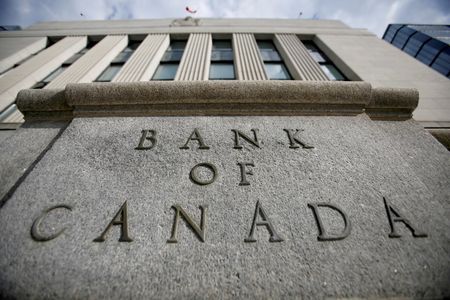By Steve Scherer and David Ljunggren
OTTAWA (Reuters) -The Bank of Canada hiked rates last month rather than leaving them unchanged because of labor market tightness and stronger-than-expected growth, according to minutes from the policy-setting meeting released on Wednesday.
The minutes suggested the Bank of Canada would likely keep rates unchanged at the next meeting, and analysts said it showed officials were on a less-aggressive policy footing than many had expected.
The minutes were released for the first time in the central bank’s history in an effort to provide more transparency, as the 87-year old institution battles to restore credibility lost when inflation spiked to more than 8%.
The central bank said a second rationale for the quarter-percentage-point rate hike was “the risk of inflation getting stuck somewhere above 2%” for the period ending in 2024.
“Data on both the labor market and economic activity suggested that there was more excess demand in the economy in the fourth quarter of 2022 than previously forecast,” the minutes said, explaining the decision to raise rates.
The bank never considered making a half-percentage-point hike, according to the minutes.
The fact that they debated whether to leave rates unchanged while most economists expected a hike “suggests a more dovish tilt among Governing Council members than was previously appreciated,” Royce Mendes, head of macro strategy at Desjardins Group, said in a note.
On Jan. 25, the Bank of Canada hiked its key interest rate to 4.5%, the highest level in 15 years, and became the first major central bank to say it would likely hold off on further increases for now. The council operates on a consensus basis and does not vote on policy decisions.
On Tuesday, Governor Tiff Macklem said no further rate hikes would be needed if, as expected, the economy stalled and inflation fell. Inflation slowed to 6.3% in December, still more than three times the central bank’s 2% target.
‘ON HOLD’
The minutes show that the central bank wanted to change its guidance after the pause in hikes, which it says is needed to gauge the effect of eight rate hikes in the past 11 months, and described what it wanted to communicate.
“Council wanted to convey that the bar for additional rate increases was now higher” and to “give a clear sense that they would need an accumulation of evidence to determine whether further rate increases would be required” to return inflation to target.
“It sounds like they’re definitely on hold in March,” said Sal Guatieri, senior economist at BMO Capital Markets. “There is definitely a desire to just stand back now and not overdo it” and tip the economy into recession, he said.
The Bank of Canada had stood out from its peers, including the U.S. Federal Reserve, the Bank of England and the European Central Bank, in not providing some form of record of their meetings until now.
The minutes, divided into four sections, covered policy meetings that began on Jan 18. The last two sections speak directly to the “considerations” made ahead of the decision, and the decision itself.
The first two sections provided an overview of the international and domestic economic context, much of which was also in the Monetary Policy Report (MPR), published on Jan. 25.
However, the members of the governing council discussed one risk to the U.S. outlook not mentioned in the MPR, which is the threat by Republicans to potentially shut down government if President Joe Biden does not reduce federal spending.
“The impending debt ceiling negotiations could be protracted and pose risks of financial volatility if an agreement were elusive,” the minutes said.
Three-quarters of all Canadian goods and services exports go to the United States.
(Reporting by Steve Scherer and David Ljunggren, editing by Deepa Babington)

